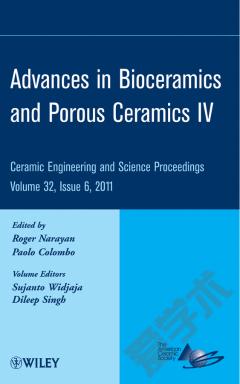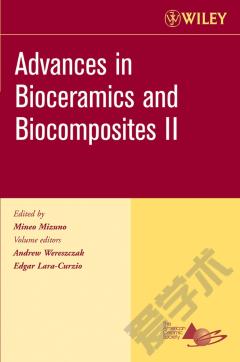Advances in Bioceramics and Porous Ceramics II
Processing of complex ceramic parts such as a dental restorations involves sintering of ceramic performs. Intended and unintended microstructures such as voids, cracks and, interfaces exist in these parts. These microstructures contribute to the mechanical response and ultimate life. A combined Xray computed micro-tomography and X-ray micro-diffraction experiment was implemented on an alumina-zirconia layered free-form fabricated composite. The composite serves as a model for examining the mechanics and material characteristics of ceramic dental restorations. The current insitu X-ray technique is capable of determining the strain values at prescribed spatial locations on the micron scale using high-energy synchrotron radiation and refractive focusing optics. In coordination with the experimental work, a finite element analysis of the volume generated by micro-tomography was developed. This required implementing a non-trivial procedure of converting the tomograph into a 3D finite element model. Simulation of sintering on this real geometry is compared with the experimental strain results for validation of the model. Once validated, the simulation offers more detailed insight to mechanical properties than experimental measurements offer on their own. This comprehensive procedure of modeling and experimentation including microtomography combined with diffraction offers a powerful method to quantify damage evolution and strain in ceramic layered composites-first intended for dental applications. yet broadly applicable as structural materials. INTRODUCTION Two of the ceramics commonly used for dental restorations are alumina and zirconia. Typically they are used independently, but their common sintering temperatures allow combination as laminates or as mixtures. Considerations for choosing these ceramics include fracture toughness, strength, cost. and their aesthetically pleasing color resembling natural teeth. In general, these highperformance ceramics are used as structural members in crowns or bridges and are overlaid with porcelain giving translucence, final color. and texture to the restoration. While they may be sintered together, alumina and zirconia have different mechanical properties such as their elastic moduli and thermal expansion coefficients. These differences in properties provide a source for residual stresses when the two materials are sintered as mixtures or laminates. They superimpose over applied stresses and can accelerate or retard cracking and failure. Under the prolonged or cyclic influence of loads, small cracks grow into larger cracks which are detrimental to the life of the part.' This is a serious problem for all bio-material applications whether considering dental restorations or implants and joint replacement prosthesis. Alternatively. the interface layer where the residual stresses exist can be tailored as a low fracture energy region to deflect cracks and induce toughening mechanisms.2 Determination of the residual stresses in such composites and laminates has been a challenging problem. The situation becomes more complicated when intricate geometries are involved, for instance a dental crown. While experiments providing bulk properties have been extensive, there is a lack of such understanding with composites. This is further complicated by the contribution of micro-scale features such as stress concentrators like pores and facets. Visualization of these defect zones in 3D is possible
{{comment.content}}








 京公网安备 11010802027623号
京公网安备 11010802027623号